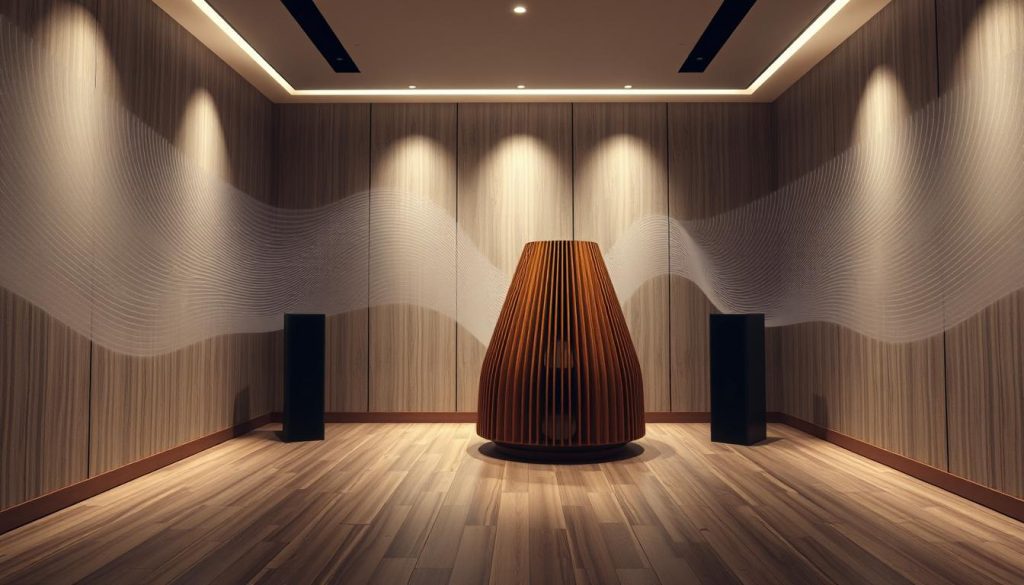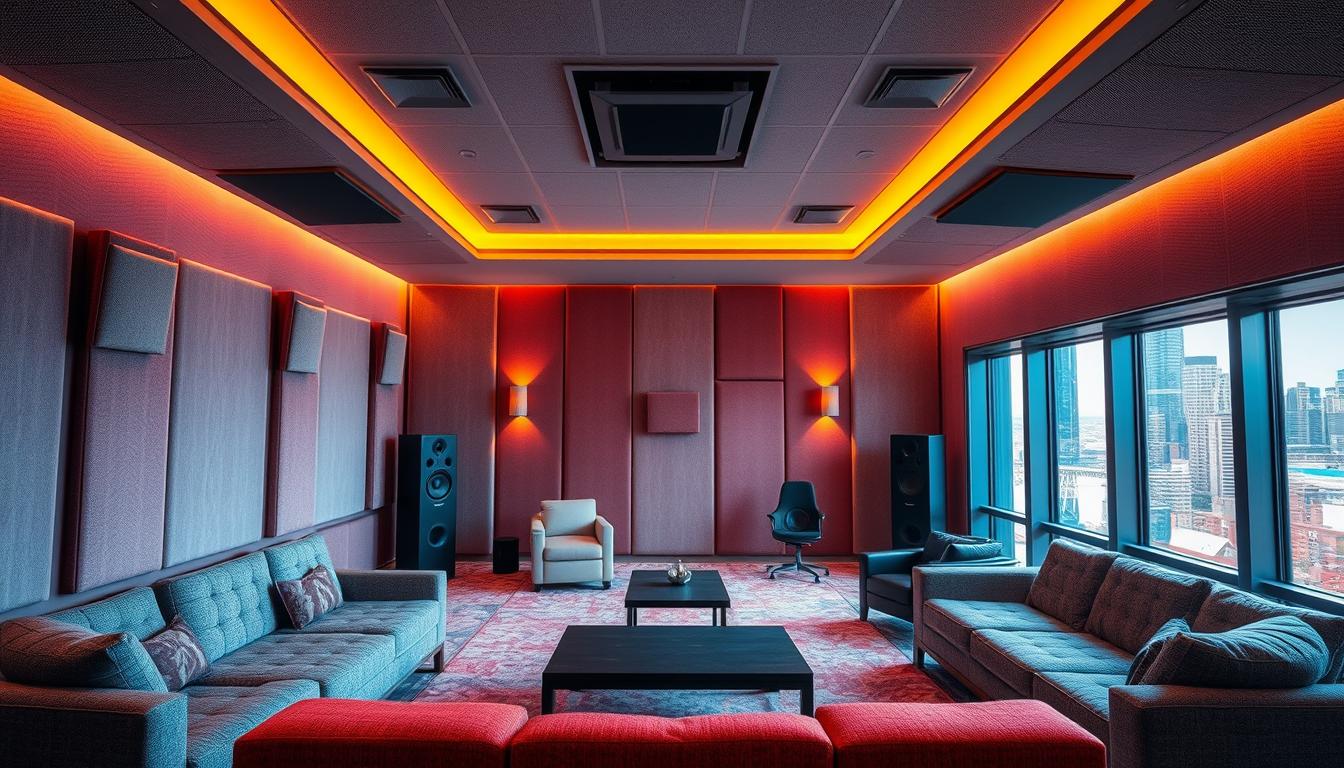I’ve always been interested in how sound works and how it interacts with our surroundings. The way sound waves bounce off surfaces affects the quality of sound in a room. It’s important to control these reflections to make the sound better.
This article will cover ways to manage sound reflection. This will help you make a room better for listening to music, recording, or just hearing speech clearly. Sound quality is not just about your speakers. It’s also about how the room affects the sound.
Things that affect room acoustics include sound wave properties, where you put furniture, and using acoustic treatments. By knowing these things, you can make your space sound better. This lets you get the most out of your audio setup.
Understanding the Fundamentals of Sound Waves
To really get sound waves, we need to know how they work. Sound can be low or high frequency. This matters a lot for how sound moves and changes in the room.
Low Frequency vs. High Frequency
Low sounds, like a bass drum or a cello, have long waves. These waves go through walls and objects easily. On the other hand, high sounds, like a violin or speech, have short waves. These waves bounce off surfaces a lot, which can change how they sound in a room.
Knowing how low and high sounds move is key to fixing sound issues. By understanding these differences, we can improve sound quality. This makes listening better in any space.
The Easy Part: Furniture and Room Setup
Optimizing room acoustics is easy. Start by placing furniture and objects wisely in the room. Items like bookshelves, curtains, carpeting, and soft seats affect sound waves.
These items absorb and spread out high-frequency sounds. This reduces echoes and makes sound clearer. Even moving a desk or chair can change how a room sounds.
Start with this simple step for better room acoustics. Arrange your furniture placement and room setup carefully. This helps with acoustic optimization and cuts down on sound reflections.
- Put big furniture like bookshelves and sofas where they can soak up sound waves.
- Place seats and listening spots away from hard surfaces to reduce sound reflections.
- Add soft, absorbent materials like curtains, rugs, and upholstered furniture for better sound absorption.
- Try moving your desk, chair, or other important items to find the best spot for acoustic optimization.
Remember these furniture placement and room setup tips. They can greatly improve your room acoustics without big changes or spending a lot. It’s a simple way to make your space sound better.
Sound Reflection Control: Managing Low Frequencies

Dealing with low-frequency sounds in a room can be tough. These sounds don’t bounce off things like higher frequencies do. This means they can make a room sound boomy or muddy, hurting the sound quality.
A Helmholtz resonator is a great way to fix these low-frequency issues. It’s a box with a special hole that absorbs certain low sounds. You can change the hole size and box volume to match the room’s problem frequencies.
Adding a Helmholtz resonator to your room can make a big difference. It helps control low sounds, making the room sound better. With it and other sound treatments, you can fix low-frequency problems for a clear, strong bass.
| Acoustic Treatment | Purpose | Recommended Placement |
|---|---|---|
| Helmholtz Resonator | Absorb specific low-frequency problem areas | Strategically placed in the room based on acoustic analysis |
| Broadband Absorbers | Reduce overall reverberation and reflections | Walls, ceiling, and corners |
| Bass Traps | Control low-frequency buildup in room corners | Corners of the room |
Using these special sound treatments can make listening better. A good room setup and these treatments help avoid unwanted sounds. Managing low frequencies is key to a great sound experience.
Tackling High Frequencies and Echoes

Improving room acoustics means tackling high-frequency reflections and echoes. These sounds can make speech unclear and audio muddy. Luckily, using sound-absorbing panels can fix this.
Acoustic Treatments and Materials
Sound-absorbing panels placed around the room can tackle high-frequency issues. The right materials and placement are key. High-density materials like mineral wool or open-cell foam work best for absorbing high frequencies.
- Mineral wool panels: Offer excellent high-frequency absorption and can help control echoes and reverberation.
- Open-cell foam panels: Highly effective at absorbing high-frequency sounds and reducing unwanted reflections.
- Perforated wood or gypsum panels: Combine sound absorption and diffusion to address both high-frequency reflections and reverberation.
By placing these panels smartly, you can make your room sound better. This improves the clarity and quality of sound in your space.
| Acoustic Treatment | Frequency Range | Absorption Characteristics |
|---|---|---|
| Mineral Wool Panels | High Frequencies | Excellent high-frequency absorption, effective at controlling echoes and reverberation |
| Open-Cell Foam Panels | High Frequencies | Highly effective at absorbing high-frequency sounds, reducing unwanted reflections |
| Perforated Wood or Gypsum Panels | Broad Frequency Range | Combine sound absorption and diffusion to address both high-frequency reflections and reverberation |
The Importance of Good Room Acoustics
Getting the right room acoustics is key for a great listening space. This is true for music, speech, or any audio. Bad acoustics can make speech unclear, audio fuzzy, and listening uncomfortable. By using smart furniture and acoustic optimization tricks, you can make your room sound better.
Good acoustics make audio sound better and help with clear communication. This means sounds are clearer, more defined, and natural. It makes listening more fun and engaging.
For a home theater, recording studio, or conference room, focus on room acoustics. This is key for the best audio quality and speech intelligibility. By improving your space’s sound, you’ll change how you hear sound. This makes your listening experience better.
| Acoustic Characteristic | Importance |
|---|---|
| Speech Intelligibility | Crucial for clear communication in professional and personal settings |
| Audio Quality | Enhances the listening experience for music, movies, and other audio content |
| Listening Comfort | Reduces fatigue and provides a more enjoyable, immersive experience |
Putting It All Together: A Comprehensive Approach
Managing room acoustics means using a full plan that covers all sound levels. This plan includes knowing how sound waves work, placing furniture right, and using special sound treatments. By mixing these methods, I can make a space that sounds clear and better overall.
Putting money into room acoustic control is key for great sound in my space. It helps with low sounds, echoes, and high sounds. This full approach to room acoustics helps me get the sound I want in my listening environment.
With a detailed, full plan for room acoustics, I can make a space that sounds amazing. This plan is a must for anyone wanting to make their space sound better. It’s good for home studios, professional recording areas, or just enjoying music at home.

